Alien Smackdown was the title of a recent lecture by Grady Cofer from ILM, we caught up with him in Sydney and asked “Just what the heck is a Sabre ?” And how does it differ from a discreet flame? We got to hear first hand how the team at ILM use the 3D compositing environment of Flame and Inferno to comp shots such as the opening of Star Wars Ep 3 and War of the Worlds. Grady showed us indepth how ILM uses Flame and especially how they use imported 3D g
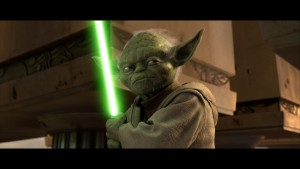 When ILM was establishing various departments, and naming them after Star Wars elements, it was decided that high speed compositing should be called “Sabre”. The basis of the Sabre department is Discreet Flame and Inferno, but with a workflow all ILM’s own.
When ILM was establishing various departments, and naming them after Star Wars elements, it was decided that high speed compositing should be called “Sabre”. The basis of the Sabre department is Discreet Flame and Inferno, but with a workflow all ILM’s own.
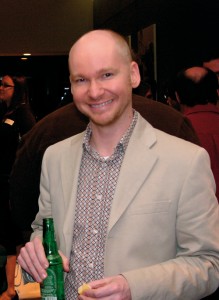 At present there are 9 infernos and 3 flames inside the the Sabre department, plus a Burn farm, and with often two shifts of operators. Two films recently to be composited by the Sabre department were Star Wars and War of the Worlds. On a recent Autodesk sponsored talking tour Grady Cofer, Digital Supervisor, at ILM Grady did an alien smackdown comparing the various tasks on each of the two films and highlighted the use of flame’s 3D compositing environment as central to the team’s workflow.
At present there are 9 infernos and 3 flames inside the the Sabre department, plus a Burn farm, and with often two shifts of operators. Two films recently to be composited by the Sabre department were Star Wars and War of the Worlds. On a recent Autodesk sponsored talking tour Grady Cofer, Digital Supervisor, at ILM Grady did an alien smackdown comparing the various tasks on each of the two films and highlighted the use of flame’s 3D compositing environment as central to the team’s workflow.
While SW Ep1 was shot on film, Ep2 and 3 were captured digitally. Ep 2 was shot 4:2:2 YUV and Ep 3 was shot RGB 4:4:4, which “much lower noise, the technology has progressed alot”, comments Cofer, referring to the advance of digital cinematography, “everything is happening relatively quickly”.
The pipeline for shots being composited in Sabre acually starts in previz of course. In the case of Ep1 most of the film was highly pre-vized, but George Lucas is a master at using parts of takes and parts of others and digitally rebuilding the performances he wants. So after principle photography and editing shots are actually handed to the shots LAYOUT department before compositing. It is their job to work out what bits of footage work with what and the strategies for doing the shots.
The internal workflow of ILM is normally a floating point EXR pipeline, but flame is not built to handle floating point. To get around this a huge library of sparks have been developed by ILM that allow the Sabre artists to work with OpenEXR files but in a 12 bit space. These sparks mimic the way elements would be combined if composited in a nodal float system, but the images are sorted as 12 bit on the array. This then allows the Sabre artists in batch to mimic the pipeline of floating point without any technical issues.
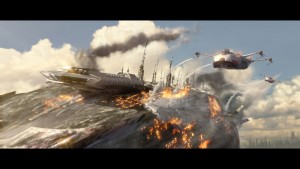 To illustrate the point and how the Sabre team uses the 3D compositing environment of Flame, Cofer broke down the opening space battle and crash landing from the start of Ep3. This entire crash landing sequence was completed in Sabre. In total the Sabre team handled over 400 shots and every shot of the opening sequence crash landing. The 3D imagery was fully rendered but additional lower poly count models were made available to Sabre, with the matching camera move. This allowed for some clever 3D compositing approaches. For example, since the ship is crash landing the team wanted to add damage to the ship. The team took shots of burning steel wool and then porjected them on to the basic geometry of the ship. The projectors were attached to the ship’s movement so the burning ‘patches’ appear to move with the ship. When graded theses images look like small fires and surface damage on the ship.
To illustrate the point and how the Sabre team uses the 3D compositing environment of Flame, Cofer broke down the opening space battle and crash landing from the start of Ep3. This entire crash landing sequence was completed in Sabre. In total the Sabre team handled over 400 shots and every shot of the opening sequence crash landing. The 3D imagery was fully rendered but additional lower poly count models were made available to Sabre, with the matching camera move. This allowed for some clever 3D compositing approaches. For example, since the ship is crash landing the team wanted to add damage to the ship. The team took shots of burning steel wool and then porjected them on to the basic geometry of the ship. The projectors were attached to the ship’s movement so the burning ‘patches’ appear to move with the ship. When graded theses images look like small fires and surface damage on the ship.
There is also a shock wave effect surrounding the ship. This surrounding bubble of rushing vapour was achieved by using blowing sand elements again projected on a 3 dimensional shape in flame, using flame’s 3D projectors parented to the model movement, with stand-in low poly geomoerty.
As the Ship breaks the atmosphere, the city is actually done in 3D Max by the DigiMatte team, while the foreground was modelled and animated in Maya. The compositing team however relit the shot with backlit lens flares and smoke, dust simulations (sims) to make the shot more dramatic. “Most sims are done as Zeno particle sims” Cofer comments. Zeno was used extensively on the recent work ILM did on Poseidon, but one of the first uses of “Zeno’s fuild dynamic simulations – based on PhysBam, was in the Lava shots at the end of Ep 3″, he adds.
The Sabre team also uses flame particle system, mainly with sprites or ParticleDraw elements, ” If you have good sprites … you can do a lot” explains Cofer.
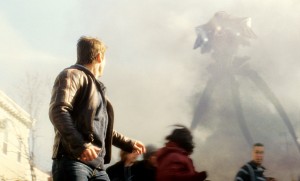 A good example of using flame’s particle system is in the opening attack in War of the Worlds (WOTW), when Tom Cruise first starts running from the intruders. While most of the particles in SW created in ILM’s Zeno package, the laser blasts or death rays in WOTW, were actually particle line animations from flame’s particle system. The often heavily persepective shot death rays were rendered and then run through various filters to give the final look. In this death ray sequence, Spielberg decided that it would be good to have the cloths left behind, as a result a massive amount of clean up was required to remove fallen actors and allow for composited second unit live action cloths and digital cloth sim cloths to fall in shot. this was made even harder by the use of a very free and handheld camera style – without any true clean plates or any use of motion control.
A good example of using flame’s particle system is in the opening attack in War of the Worlds (WOTW), when Tom Cruise first starts running from the intruders. While most of the particles in SW created in ILM’s Zeno package, the laser blasts or death rays in WOTW, were actually particle line animations from flame’s particle system. The often heavily persepective shot death rays were rendered and then run through various filters to give the final look. In this death ray sequence, Spielberg decided that it would be good to have the cloths left behind, as a result a massive amount of clean up was required to remove fallen actors and allow for composited second unit live action cloths and digital cloth sim cloths to fall in shot. this was made even harder by the use of a very free and handheld camera style – without any true clean plates or any use of motion control.
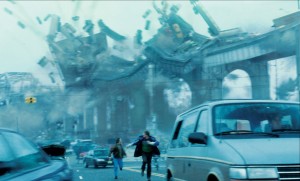 At the end of this long sequence there is a massive driving shot that was changed to be much longer on set. Apparently Speilberg turned one day to ILM Supervisor Pablo Helman and said “what if?” There was not time for detailed planning or pre-viz, after a certain point on the car escaping the death rays, there was no animatic, no storyboard and the team just improvised. To make this shot work as it was shot from a traveling camera track, massive amounts of camera tracking was required. Zeno is used for match moves, and then the moves are imported to Flame where rough geometry and projector cards are placed into the moving 3D shot. the result is a moving wireframe overlayed over the background live action in flame’s action module. Into this projectors projected model shots of buildings being destroyed. The Models were made to match as closely as possible to the real houses, and then the Sabre team skillfully blended the two images together. This was helped as the projected houses were moving in perspective thanks to Flame’s 3D camera.
At the end of this long sequence there is a massive driving shot that was changed to be much longer on set. Apparently Speilberg turned one day to ILM Supervisor Pablo Helman and said “what if?” There was not time for detailed planning or pre-viz, after a certain point on the car escaping the death rays, there was no animatic, no storyboard and the team just improvised. To make this shot work as it was shot from a traveling camera track, massive amounts of camera tracking was required. Zeno is used for match moves, and then the moves are imported to Flame where rough geometry and projector cards are placed into the moving 3D shot. the result is a moving wireframe overlayed over the background live action in flame’s action module. Into this projectors projected model shots of buildings being destroyed. The Models were made to match as closely as possible to the real houses, and then the Sabre team skillfully blended the two images together. This was helped as the projected houses were moving in perspective thanks to Flame’s 3D camera.
Black velvet smoke boxes were also shot allowing for additive keying of smoke elements over live action projected model work. Model trucks up to five feet long were crashed. Over the course of the effects production Steven Speilberg asked for progressively more and more cars to be added to the shot to be destroyed. In the end the overhead road is jam packed with cars, mainly digital, but the model shop did build real physical uprights and supporting structures.
The whole shot took 12 weeks to achieve.
Like the shock wave on the crash landing in SW, 3D geometry was used in WOTW. When the intruders are fired upon, their forcefields are actually simple spheres in flame, tracked and then projected on with small explosions from the ILm stock library. As the explosions warp around the bubble or sphere – it gives the illusion of a forcefield.
ILM makes heavy use of soft import, allowing setups to be built and then linked to the centralized file store of ILM and updated as shots are revised. This coupled with Burn have made big productivity improvements to the Sabre team.
